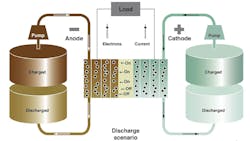Have you been following the south pole lunar lander adventure? I find space exploration coverage a great place for discovering cutting-edge technologies that are about to become part of our daily life. That’s where the computer mouse and wireless headsets came from, along with many others. This latest lunar lander, nicknamed Odie, gave me lots to think about technology wise too.
Odie tripped upon landing and ended up on its side rather than the normal upright position. It impacted the mission by compromising its solar panels. They could not provide enough power for the full mission and now the weeklong mission was reduced to a few days. Why was it so short in the first place? Well, at the south pole landing site the solar day is only a little over a week and the long lunar night freezes electronics. I hadn’t read much about the lunar day/night cycles or the challenge they represent to providing sustainable electricity for permanent lunar bases.
Extraterrestrial power generation is a pressing issue and researchers are turning to technology for dependable power supplies. They ranged from radioisotope power plants to solar panels mounted on a fleet of lunar rovers dragging power cables behind them as they followed the movement of the sun. There’s also a great deal of research taking place with battery technologies to find a viable alternative to lithium-ion (Li-ion) batteries, which will find its way to the power grid.
Old is New Again
Metal-hydrogen batteries have been around for a long time, and have been used in some amazing space applications, which have proven to be dependable on long missions in the severe conditions of space. Recent advancements in metal-hydrogen batteries have made them more attractive for power grid applications. EnerVenue announced an advancement in the metal-hydrogen chemistry that reduces costs and improves metal-hydrogen battery performance. They are planning to open a metal-hydrogen battery gigafactory in Kentucky.
The redox-flow battery is another established battery technology that has been getting attention lately as researchers improve its characteristics. Basically a redox-flow battery consists of two tanks and stores energy in liquid electrolytes containing ions. The two electrolytes are pumped through separate electrodes separated by a thin membrane. The membrane keeps the two fluids apart, but permits the exchange of ions producing current. These conventional redox-flow batteries are extremely bulky with their large tanks housing the large volumes of electrolytes and have a low energy density.
Still the principles behind redox-flow technology have proven sound and power output and energy capacity can be increased by increasing the volume of the battery. As a result, several companies have developed conventional redox-flow batteries for utility-scale energy storage applications. Over the past decade research on redox-flow found capacity can be increased with nanofluid technology. Nanofluids are more energy dense and can remain suspended in the fluid indefinitely. This nanoelectrofuel (NEF) has reshaped redox-flow batteries.
Move Over Li-ion
The nanoelectrofuel-flow battery utilizes four tanks, two for charged electrolytes and two for discharged electrolytes along with pumps, and membranes. The nanofluids take up a much smaller space so the configuration is more compact. NEF fluids have ultra energy density compared to the conventional redox battery fluids. A press release from Influit Energy said they have developed a NEF-flow battery that has a 23% higher energy density than Li-ion batteries and it’s cheaper. They are projecting their second generation NEF battery should have 5 times the energy density of today’s Li-ion batteries, and they are nonflammable and non-explosive.
DARPA has been funding the development of NEF batteries used for electric vehicles (EVs). The military needs EVs that can perform anywhere, and the NEF batteries are meeting the challenge. An EV NEF-flow battery provides the driving range needed by both military and civilians. Plus NEF-flow batteries can be recharged like Li-ion batteries, but they also allow the battery to be recharged by removing the depleted electrolyte and replaced with charged electrolyte. It’s about a 5-minute process and it’s a gamechanger for EVs.
On the utility side, grid-scale energy storage NEF-flow batteries have a lot going for them too. They are more environmentally friendly than Li-ion batteries because of the materials they use and the have longer cycle life. It’s estimated these NEF-flow batteries can be charged/discharged at least 30,000 times in their lifetimes, which is much better than Li-ion batteries. By all indications, NEF-flow batteries appear to be ready to go mainstream and become an energy storage disrupter that we need to watch!
About the Author
Gene Wolf
Technical Editor
Gene Wolf has been designing and building substations and other high technology facilities for over 32 years. He received his BSEE from Wichita State University. He received his MSEE from New Mexico State University. He is a registered professional engineer in the states of California and New Mexico. He started his career as a substation engineer for Kansas Gas and Electric, retired as the Principal Engineer of Stations for Public Service Company of New Mexico recently, and founded Lone Wolf Engineering, LLC an engineering consulting company.
Gene is widely recognized as a technical leader in the electric power industry. Gene is a fellow of the IEEE. He is the former Chairman of the IEEE PES T&D Committee. He has held the position of the Chairman of the HVDC & FACTS Subcommittee and membership in many T&D working groups. Gene is also active in renewable energy. He sponsored the formation of the “Integration of Renewable Energy into the Transmission & Distribution Grids” subcommittee and the “Intelligent Grid Transmission and Distribution” subcommittee within the Transmission and Distribution committee.
